Antigua and Barbuda
Coordinates: 17°03′N 61°48′W / 17.050°N 61.800°W
| Antigua and Barbuda |
||||||
|---|---|---|---|---|---|---|
|
||||||
| Motto: "Each Endeavouring, All Achieving" | ||||||
| Anthem: Fair Antigua, We Salute Thee Royal anthem: God Save the Queena |
||||||
 |
||||||
_-_ATG_-_UNOCHA.svg.png) |
||||||
| Capital and largest city | St. John's 17°7′N 61°51′W / 17.117°N 61.850°W | |||||
| Official languages | English | |||||
| Ethnic groups (1996) | 89% Black 4.4% Mixed 2.4% White 2.5% Other |
|||||
| Demonym | Antiguan Barbudan |
|||||
| Government | Parliamentary democracy under constitutional monarchy | |||||
| • | Monarch | Elizabeth II | ||||
| • | Governor-General | Rodney Williams | ||||
| • | Prime Minister | Gaston Browne | ||||
| Legislature | Parliament | |||||
| • | Upper house | Senate | ||||
| • | Lower house | House of Representatives | ||||
| Independence | ||||||
| • | Associated State | 27 February 1967 | ||||
| • | from the United Kingdom | 1 November 1981 | ||||
| Area | ||||||
| • | Total | 440 km2 (195th) 170 sq mi |
||||
| • | Water (%) | negligible | ||||
| Population | ||||||
| • | 2014 estimate | 91,295 (199th) | ||||
| • | 2011 census | 81,799 | ||||
| • | Density | 186/km2 481/sq mi |
||||
| GDP (PPP) | 2016 estimate | |||||
| • | Total | $2.159 billion[1] | ||||
| • | Per capita | $23,922[1] | ||||
| GDP (nominal) | 2016 estimate | |||||
| • | Total | $1.332 billion[1] | ||||
| • | Per capita | $14,753[1] | ||||
| HDI (2014) | high · 58th |
|||||
| Currency | East Caribbean dollar (XCD) | |||||
| Time zone | AST (UTC-4) | |||||
| Drives on the | left | |||||
| Calling code | +1-268 | |||||
| ISO 3166 code | AG | |||||
| Internet TLD | .ag | |||||
| a. | "God Save the Queen" is the official national anthem, but is generally used only on regal and vice-regal occasions. | |||||
Antigua and Barbuda (![]() i/ænˈtiːɡə ənᵈ bɑːrˈbjuːdə/; an-TEE-gǝ ǝnd bar-BYOO-dǝ;) is a twin-island country in the Americas, lying between the Caribbean Sea and the Atlantic Ocean. It consists of two major inhabited islands, Antigua and Barbuda, and a number of smaller islands (including Great Bird, Green, Guinea, Long, Maiden and York Islands and further south, the island of Redonda). The permanent population numbers about 81,800 (at the 2011 Census) and the capital and largest port and city is St. John's, on Antigua.
i/ænˈtiːɡə ənᵈ bɑːrˈbjuːdə/; an-TEE-gǝ ǝnd bar-BYOO-dǝ;) is a twin-island country in the Americas, lying between the Caribbean Sea and the Atlantic Ocean. It consists of two major inhabited islands, Antigua and Barbuda, and a number of smaller islands (including Great Bird, Green, Guinea, Long, Maiden and York Islands and further south, the island of Redonda). The permanent population numbers about 81,800 (at the 2011 Census) and the capital and largest port and city is St. John's, on Antigua.
Separated by a few nautical miles, Antigua and Barbuda are in the middle of the Leeward Islands, part of the Lesser Antilles, roughly at 17°N of the equator. The country's name was given by Christopher Columbus in 1493 after discovering the island, in honor of the Virgin of La Antigua in the Seville Cathedral. The country is nicknamed "Land of 365 Beaches" due to the many beaches surrounding the islands. Its governance, language, and culture have all been strongly influenced by the British Empire, of which the country was formerly a part.
Etymology
Antigua is Spanish for "ancient" and Barbuda is Spanish for "bearded". The island of Antigua, originally called Wa'ladli by Arawaks, is today called Wadadli by locals. Caribs possibly called it Wa'omoni. Christopher Columbus, while sailing by in 1493 may have named it Santa Maria la Antigua, after an icon in the Spanish Seville Cathedral.
History
Antigua was first settled by archaic age hunter-gatherer Amerindians called the Siboney or Ciboney.[3] Carbon dating has established the earliest settlements started around 3100 BC. They were succeeded by the ceramic age pre-Columbian Arawak-speaking Saladoid people who migrated from the lower Orinoco River.
The Arawaks introduced agriculture, raising, among other crops, the famous Antigua black pineapple (Moris cultivar of Ananas comosus), corn, sweet potatoes (white with firmer flesh than the bright orange "sweet potato" most often used in the United States), chiles, guava, tobacco, and cotton.
The indigenous West Indians made excellent seagoing vessels which they used to sail across the Atlantic and the Caribbean. As a result, Caribs and Arawaks were able to colonise much of South America and the Caribbean Islands. Their descendants still live there, notably in Brazil, Venezuela, and Colombia.
Most Arawaks left Antigua around 1100 AD; those who remained were later raided by the Caribs. According to the Catholic Encyclopedia, the Caribs' superior weapons and seafaring prowess allowed them to defeat most of the West Indian Arawak nations, enslaving some and possibly cannibalising others.
%2C_plate_V_-_BL.jpg)
The Catholic Encyclopedia makes it clear that the European invaders had difficulty differentiating between the various groups of the native peoples they encountered. As a result, the number and types of ethnic/tribal groups in existence at that time may have been much more varied and numerous than just the two mentioned in this article.
European and African diseases, malnutrition, and slavery eventually killed most of the Caribbean's native population. Smallpox was probably the greatest killer.[4] Some historians believe that the psychological stress of slavery may also have played a part in the massive number of deaths amongst enslaved natives. Others believe the reportedly abundant but starchy, low-protein diet may have contributed to their severe malnutrition as they were used to a diet fortified with protein from the sea.[5]
The Spaniards did not colonise Antigua because it lacked fresh water but not aggressive Caribs. The English settled on Antigua in 1632; Sir Christopher Codrington settled on Barbuda in 1684. Slavery, established to run sugar plantations around 1684, was abolished in 1834. The British ruled from 1632 to 1981, with a brief French interlude in 1666.
The islands became an independent state within the Commonwealth of Nations on 1 November 1981, with Elizabeth II as the first Queen of Antigua and Barbuda. The Right Honourable Vere Cornwall Bird Sr became the first Prime Minister.
Geography


Antigua and Barbuda both are generally low-lying islands whose terrain has been influenced more by limestone formations than volcanic activity. The highest point on Antigua is Mount Obama (formerly Boggy Peak), the remnant of a volcanic crater rising 402 metres (1,319 feet).
The shorelines of both islands are greatly indented with beaches, lagoons, and natural harbours. The islands are rimmed by reefs and shoals. There are few streams as rainfall is slight. Both islands lack adequate amounts of fresh groundwater.
Islands
Climate
Rainfall averages 990 mm (39 in) per year, with the amount varying widely from season to season. In general the wettest period is between September and November. The islands generally experience low humidity and recurrent droughts. Hurricanes strike on an average of once a year. Temperatures average 27 °C (80.6 °F), with a range from 23 °C (73.4 °F) in the winter to 30 °C (86 °F) in the summer and autumn. The coolest period is between December and February. Its low humidity makes it one of the most temperate climates in the world.
Ecology
The sandy soil on much of the islands has only scrub vegetation. Some parts of Antigua are more fertile–most notably the central plain–due to the volcanic ash in the soil. These areas support some tropical vegetation and agricultural uses. The planting of acacia, mahogany, and red and white cedar on Antigua has led to as much as 11% of the land becoming forested, helping to conserve the soil and water.
Governance
Political system

The politics of Antigua and Barbuda take place within a framework of a unitary, parliamentary, representative democratic monarchy, in which the Head of State is the Monarch who appoints the Governor General as vice-regal representative.[7] Elizabeth II is the present Queen of Antigua and Barbuda, having served in that position since the islands' independence from the United Kingdom in 1981. The Queen is currently represented by Governor General Sir Rodney Williams. A Council of Ministers is appointed by the Governor General on the advice of the Prime Minister, currently Gaston Browne (2014–). The Prime Minister is the Head of Government.
Executive power is exercised by the government while legislative power is vested in both the government and the two Chambers of Parliament. The bicameral Parliament consists of the Senate (17 members appointed by members of the government and the opposition party, and approved by the Governor-General), and the House of Representatives (17 members elected by first past the post) to serve five-year terms.
The current Leader of Her Majesty's Loyal Opposition is the United Progressive Party Member of Parliament (MP), the Honourable Baldwin Spencer.
Political culture

Gaston Browne defeated his predecessor Lester Bryant Bird at the party's biennial convention in November 2012 held to elect a political leader and other party officers. The party then altered its name from the Antigua Labour Party (ALP) to the Antigua & Barbuda Labour Party (ABLP). This was done to officially include the party's presence on the sister isle of Barbuda in its organisation, the only political party on the mainland to have a physical branch in Barbuda.
The last elections held were on 12 June 2014, during which the Antigua Labour Party won 14 seats, and the United Progressive Party 3 seats.
Since 1949, the party system had been dominated by the populist Antigua Labour Party. However, the Antigua and Barbuda legislative election of 2004 saw the defeat of the longest-serving elected government in the Caribbean. Prime Minister Lester Bryant Bird, who had succeeded his father Vere Cornwall Bird Sr., and Deputy Robin Yearwood had been in office since 1976.
The elder Bird was Prime Minister from 1981 to 1994 and Chief Minister of Antigua from 1960 to 1981, except for the 1971–1976 period when the Progressive Labour Movement (PLM) defeated his party. Vere Cornwall Bird, the nation's first Prime Minister, is credited with having brought Antigua and Barbuda and the Caribbean into a new era of independence.
Judiciary
The Judicial branch is the Eastern Caribbean Supreme Court (based in Saint Lucia; one judge of the Supreme Court is a resident of the islands and presides over the High Court of Justice). Antigua is also a member of the Caribbean Court of Justice. The Judicial Committee of the Privy Council serves as its Supreme Court of Appeal.
Foreign relations
Antigua and Barbuda is a member of the United Nations, the Bolivarian Alliance for the Americas, the Commonwealth of Nations, the Caribbean Community, the Organization of Eastern Caribbean States, the Organization of American States, the World Trade Organization and the Eastern Caribbean's Regional Security System.
Antigua and Barbuda is also a member of the International Criminal Court (with a Bilateral Immunity Agreement of Protection for the US military as covered under Article 98 of the Rome Statute).
In 2013, Antigua and Barbuda called for reparations for slavery at the United Nations. Prime Minister Baldwin Spencer said "We have recently seen a number of leaders apologising", and that they should now "match their words with concrete and material benefits".[8]
Military
The Royal Antigua and Barbuda Defence Force has around 260 members dispersed between the line infantry regiment, service and support unit and coast guard. There is also the Antigua and Barbuda Cadet Corps made up of 200 teenagers between the ages of 12 to 18.
Administrative divisions
Antigua and Barbuda is divided into six parishes and two dependencies:
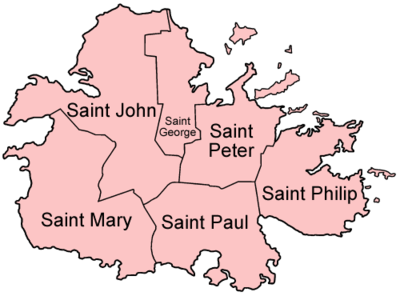
|
|
Note: Though Barbuda and Redonda are called dependencies they are integral parts of the state, making them essentially administrative divisions. Dependency is simply a title.
Economy

Tourism dominates the economy, accounting for more than half of the Gross Domestic Product (GDP). Antigua is famous for its many luxury resorts. Weak tourist activity since early 2000 has slowed the economy, however, and squeezed the government into a tight fiscal corner.
Investment banking and financial services also make up an important part of the economy. Major world banks with offices in Antigua include the Royal Bank of Canada (RBC) and Scotiabank. Financial-services corporations with offices in Antigua include PriceWaterhouseCoopers. The US Securities and Exchange Commission has accused the Antigua-based Stanford International Bank, owned by Texas billionaire Allen Stanford, of orchestrating a huge fraud which may have bilked investors of some $8 billion.[9] (check status 20100312)
The twin-island nation's agricultural production is focused on its domestic market and constrained by a limited water supply and a labour shortage stemming from the lure of higher wages in tourism and construction work.
Manufacturing is made up of enclave-type assembly for export, the major products being bedding, handicrafts and electronic components. Prospects for economic growth in the medium term will continue to depend on income growth in the industrialised world, especially in the United States, from which about one-third of all tourists come.
Following the opening of the American University of Antigua College of Medicine by investor and attorney Neil Simon in 2003, a new source of revenue was established. The university employs many local Antiguans and the approximate 1000 students consume a large amount of the goods and services.
Demographics

Ethnic groups
Antigua has a population of 85,632, mostly made up of people of West African, British, and Madeiran descent. The ethnic distribution consists of 91% Black, 4.4% mixed race, 1.7% White, and 2.9% other (primarily East Indian and Asian). Most Whites are of Irish or British descent. Christian Levantine Arabs, and a small number of Asians and Sephardic Jews make up the remainder of the population.
An increasingly large percentage of the population lives abroad, most notably in the United Kingdom (Antiguan Britons), United States and Canada. A minority of Antiguan residents are immigrants from other countries, particularly from Dominica, Guyana and Jamaica, and, increasing, from the Dominican Republic, St. Vincent and the Grenadines and Nigeria. An estimated 4,500 American citizens also make their home in Antigua and Barbuda, making their numbers one of the largest American populations in the English-speaking Eastern Caribbean.[10]
Languages
English is the official language.The Barbudan accent is slightly different from the Antiguan.
In the years before Antigua and Barbuda's independence, Standard English was widely spoken in preference to Antiguan Creole. Generally, the upper and middle classes shun Antiguan Creole. The educational system dissuades the use of Antiguan Creole and instruction is done in Standard (British) English.
Many of the words used in the Antiguan dialect are derived from British as well as African languages. This can be easily seen in phrases such as: "Ent it?" meaning "Ain't it?" which is itself dialectal and means "Isn't it?". Common island proverbs can often be traced to Africa.
Spanish is spoken by around 10,000 inhabitants.[11]
Largest cities
| Largest cities or towns in Antigua and Barbuda www | |||||||||
|---|---|---|---|---|---|---|---|---|---|
| Rank | Name | Parish | Pop. | ||||||
 Saint John's  All Saints |
1 | Saint John's | Saint John | 24,226 | |||||
| 2 | All Saints | Saint John | 2,526 | ||||||
| 3 | Liberta | Saint Paul | 1,668 | ||||||
| 4 | Bolands | Saint Mary | 1,657 | ||||||
| 5 | Potters Village | Saint John | 1,433 | ||||||
| 6 | Parham | Saint Peter | 969 | ||||||
| 7 | Carlisle | Saint George | 831 | ||||||
| 8 | Cedar Crove | Saint John | 789 | ||||||
| 9 | Swetes | Saint Paul | 727 | ||||||
| 10 | Codrington | Barbuda | 682 | ||||||
Religion
74%[12] of Antiguans are Christians, with the Anglicans (about 44%) being the largest single denomination. Other Christian denominations present are Baptists,[13] Presbyterians[14][15] and Roman Catholics.
Non-Christian religions practised in the islands include the Rastafari Movement, Islam, Judaism and the Bahá'í Faith.
Education
Antigua & Barbuda has a greater than 90% literacy rate. In 1998, Antigua and Barbuda adopted a national mandate to become the pre-eminent provider of medical services in the Caribbean. As part of this mission, Antigua and Barbuda built the most technologically advanced hospital in the Caribbean, the Mt. St. John Medical Centre. The island of Antigua currently has two foreign-owned for-profit offshore medical schools, the American University of Antigua (AUA),[16] founded in 2004, and The University of Health Sciences Antigua (UHSA),[17] founded in 1982. The island's sole medical schools cater mostly to foreign students but contribute tremendously to the local economy and health care and help give the small country international attention.
There is also a government owned state college in Antigua as well as the Antigua and Barbuda Institute of Information Technology (ABIIT) and the Antigua and Barbuda Hospitality Training Institute (ABHTI). The University of the West Indies has a branch in Antigua for locals to continue university studies.
Antigua has two international primary/secondary schools Including CCSET International, which offers the Ontario Secondary School Diploma, and Island Academy, which offers the International Baccalaureate. There are also many other private schools but these institutions tend to follow the same local curriculum (CXCs) as government schools. Both international schools are relatively inexperienced with offering international degrees. CCSET international has existed for several years but only began offering an International Degree in 2007. While CCSET's graduating classes have consistently been awarded the OSSD, this is somewhat controversial because CCSET students receive their diplomas from one of CCSET's (constantly changing) partner schools based in Ontario.
Culture
The culture is predominantly a mixture of West African and British cultural influences.
Cricket is the national sport and Antigua has produced several famous cricket players including Sir Vivian Richards, Anderson "Andy" Roberts, and Richard "Richie" Richardson. Other popular sports include football, boat racing and surfing. (Antigua Sailing Week attracts locals and visitors from all over the world).
American popular culture and fashion also have a heavy influence. Most of the country's media is made up of major United States networks. Many Antiguans prefer to make shopping trips to San Juan, Puerto Rico.
Family and religion play an important roles in the lives of Antiguans. Most attend religious services on Sunday, although there is a growing number of Seventh-day Adventists who observe the Sabbath on Saturday.
Calypso and soca music, both originating primarily out of Trinidad, are important in Antigua and Barbuda.[18]
Festivals
The national Carnival held each August commemorates the abolition of slavery in the British West Indies, although on some islands, Carnival may celebrate the coming of Lent. Its festive pageants, shows, contests and other activities are a major tourist attraction.
Cuisine
Corn and sweet potatoes play an important role in Antiguan cuisine. For example, a popular Antiguan dish, Dukuna /ˈduː.kuːˌnɑː/ is a sweet, steamed dumpling made from grated sweet potatoes, flour and spices. One of the Antiguan staple foods, fungi /ˈfuːn.dʒiː/, is a cooked paste made of cornmeal and water.
Media
There are two daily newspapers: the "Daily Observer" and "Caribbean Times". Besides most American television networks, the local channel ABS TV 10 is available (it is the only station which shows exclusively local programs). There are also several local and regional radio stations, such as V2C-AM 620, ZDK-AM 1100, VYBZ-FM 92.9, ZDK-FM 97.1, Observer Radio 91.1 FM, DNECA Radio 90.1 FM, Second Advent Radio 101.5 FM, Abundant Life Radio 103.9 FM, Crusader Radio 107.3 FM, Nice FM 104.3
Sports
The Antigua and Barbuda national cricket team represented the country at the 1998 Commonwealth Games, but Antiguan cricketers otherwise play for the Leeward Islands cricket team in domestic matches and the West Indies cricket team internationally. The 2007 Cricket World Cup was hosted in the West Indies from 11 March to 28 April 2007.
Antigua hosted eight matches at the Sir Vivian Richards Stadium, which was completed on 11 February 2007 and can hold up to 20,000 people. Antigua is a Host of Stanford Twenty20 – Twenty20 Cricket, a version started by Allen Stanford in 2006 as a regional cricket game with almost all Caribbean islands taking part. Antiguan Viv Richards scored the fastest Test Century and Brian Lara twice scored the World Test Record at the Antigua Recreation Ground.
Association football, or soccer, is also a very popular sport. Antigua has a national football team which entered World Cup qualification for the 1974 tournament and for 1986 and onwards. A professional team was formed in 2011, Antigua Barracuda FC, which played in the USL Pro, a lower professional league in the USA. The nation's team had a major achievement in 2012, getting out of its preliminary group for the 2014 World Cup, notably due to a victory over powerful Haiti. In its first game in the next CONCACAF group play on 8 June 2012 in Tampa, FL, Antigua and Barbuda, comprising 17 Barracuda players and 7 from the lower English professional leagues, scored a goal against the United States, authored by Peter Byers; however, the team lost 3:1 to the US.
Athletics are popular. Talented athletes are trained from a young age, and Antigua and Barbuda has produced a few fairly adept athletes. Janill Williams, a young athlete with much promise comes from Gray's Farm, Antigua. Sonia Williams and Heather Samuel represented Antigua and Barbuda at the Olympic Games. Other prominent rising stars include Brendan Christian (100 m, 200 m), Daniel Bailey (100 m, 200 m) and James Grayman (high jump).
See also
- Outline of Antigua and Barbuda
- Index of Antigua and Barbuda-related articles
- Bibliography of Antigua and Barbuda
-
 Antigua and Barbuda – Wikipedia book
Antigua and Barbuda – Wikipedia book
References
- 1 2 3 4 "Antigua and Barbuda". International Monetary Fund. 2016. Retrieved 1 April 2016.
- ↑ (PDF) http://hdr.undp.org/sites/default/files/hdr_2015_statistical_annex.pdf. Missing or empty
|title=(help) |title=2015 Human Development Report |date=2015 |accessdate=14 December 2015 |publisher=United Nations Development Programme | - ↑ "Introduction ::Antigua and Barbuda".
- ↑ Austin Alchon, Suzanne (2003). A pest in the land: new world epidemics in a global perspective. University of New Mexico Press. pp. 62–63. ISBN 0-8263-2871-7.
- ↑ Rogozinski, Jan (September 2000). A Brief History of the Caribbean. Penguin Putnam, Inc.
- ↑ http://www.oecs.org/publications/Fdoc_download/450-north-east-marine-management-area-management-plan
- ↑ "Antigua and Barbuda 1981". Constitute. Retrieved 20 February 2015.
- ↑ "Slavery reparations: Blood money". The Economist. 5 October 2013.
- ↑ Krauss, Clifford; Creswell, Julie; Savage, Charlie (21 February 2009). "Fraud Case Shakes a Billionaire's Caribbean Realm". The New York Times. Retrieved 14 April 2010.
- ↑ "Background Note: Antigua and Barbuda". Archived from the original on 14 August 2007. Retrieved 23 August 2007.
- ↑ Bernadette Farquhar - The Spanish Language in Antigua and Barbuda: Implications for Language Planning and Language Research Archived 15 July 2013 at the Wayback Machine.
- ↑ "Antigua and Barbuda: International Religious Freedom Report 2006". 15 September 2006. Archived from the original on 21 November 2006. Retrieved 23 August 2007.
- ↑
- ↑ An Introduction to Southern Presbyterian History (1611-2001)
- ↑ Mark A. Noll (1992). A History of Christianity in the United States and Canada - Mark A. Noll. Wm. B. Eerdmans Publishing Company. ISBN 9780802806512.
- ↑ "American University of Antigua, College of Medicine". Archived from the original on 22 August 2007. Retrieved 23 August 2007.
- ↑ "University of Health Sciences Antigua". Retrieved 23 August 2007.
- ↑ "Antigua & Barbuda - Carnival & Music". www.geographia.com. Retrieved 2016-11-09.
External links
| The Wikibook Wikijunior:Countries A-Z has a page on the topic of: Antigua and Barbuda |
- The Official Website of the Government of Antigua and Barbuda
-
 Wikimedia Atlas of Antigua and Barbuda
Wikimedia Atlas of Antigua and Barbuda - Antigua and Barbuda, United States Library of Congress
- "Antigua and Barbuda". The World Factbook. Central Intelligence Agency.
- Antigua and Barbuda from UCB Libraries GovPubs
- Antigua and Barbuda at DMOZ
- Antigua and Barbuda from the BBC News
- World Bank's country data profile for Antigua and Barbuda
- ArchaeologyAntigua.org – 2010March13 source of archaeological information for Antigua and Barbuda
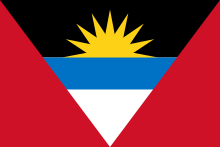


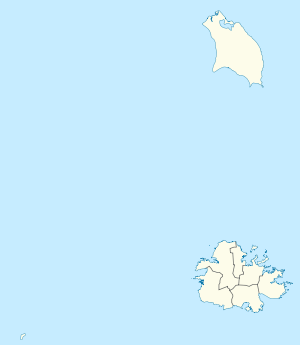
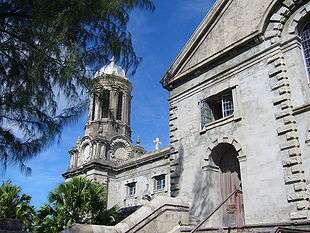
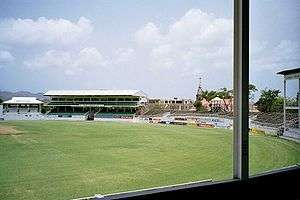
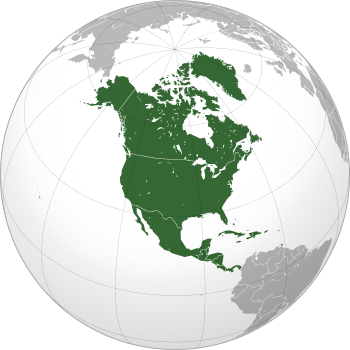


Countries.png)